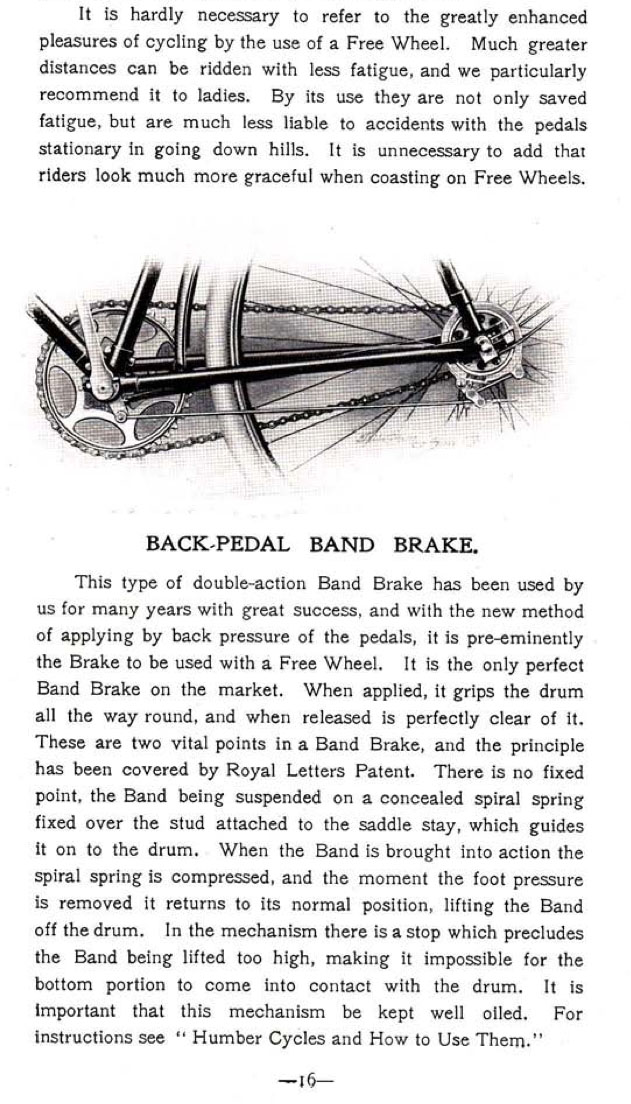
1900 Humber First Grade Free Wheel Lady’s Safety, No 23
Featuring the Humber Back-Pedal Band Brake
And the First Front Rim Brake
Frame No 79357
(Now sold)
It is hardly necessary to refer to the greatly enhanced pleasures of cycling by the use of a Free Wheel. Much greater distances can be ridden with less fatigue, and we particularly recommend it to ladies. By its use they are not only saved fatigue, but are much less liable to accidents with the pedals stationary in going down hills. It is unnecessary to add that riders look much more graceful when coasting on free wheels.

In 1900, the final year of the nineteenth century – and, with Queen Victoria’s death, the end of an era – bicycle brakes were still a novelty. The freewheel hub had only come onto the market three years before, making bicycles much easier for ordinary folks to ride. Manufacturers started to fit front and rear brakes to enable riders to coast downhill without the dangers that had been prevalent throughout the 1890s.
But the cars and motorcycles that were in the development stage at the turn of the century required even more efficient braking systems than bicycles, and the companies were forced to accelerate the evolution of braking technology. Bicycles, of course, benefited from this and, by 1905, brakes and free wheel geared hubs such as those still in use today, had become standard.
Introduced at the same time as the free wheel hub, and covered by Humber patents, the back-pedal band brake was a state-of-the-art device. This bicycle would have been the envy of other cyclists. Within just a few years as brakes evolved further, the band brake became obsolete. With few vintage machines now fitted with one, it has become an item of curiosity.
However, the real curiosity on this 1900 bicycle is actually the front rim brake. Previously ‘spoon’ brakes were used at the front, and 1900 was the first year for this revolutionary device. Though mentioned as an option, the 1900 Humber catalogue did not illustrate the rim brake. But you can see it fully explained in the 1901 catalogue further down the page:
We have completely re-designed this for the coming season, and without doubt we have the neatest and lightest brake, consistent with efficiency, on the market. It is very powerful, and generally can be applied sufficiently with one finger to stop the machine. This is one of the great advantages of a rim over a spoon brake. Being exceptionally powerful, it does not require the same exertion to apply it, and it is as well to remember that only a portion of its power need be used. When free-wheeling, we strongly recommend assisting the back-pedal brake with the front rim brake when descending very long or steep hills.










BRIGHTON CYCLE & MOTOR COMPANY
9 MARINE PARADE, BRIGHTON

The Brighton Cycle & Motor Co exhibited at the 1897 Brighton Motor & Cycle Exhibition, which was held at the Brighton Aquarium, directly opposite these premises. No doubt this shop, pictured above in the same year, was established for that reason. The Company’s stand featured a motor-tricycle and motor-tandem, as well as ‘a Daimler motor-carriage, on which visitors were able to take frequent trips.’ I visited the site of Brighton Cycle & Motor Co though, as you can see below, little remains of its former glory. In fact, it became a hotel by 1901. It’s now one of Brighton’s top gay venues.










THE BACK-PEDAL BAND BRAKE








The bicycle in the photo below, probably from 1899, also appears to have a rear band brake. The spoon brake at the front was an option for a few years after new front rim brake, such as on this Humber, came on the market. In Germany, the front spoon brake continued for another fifty years.










































